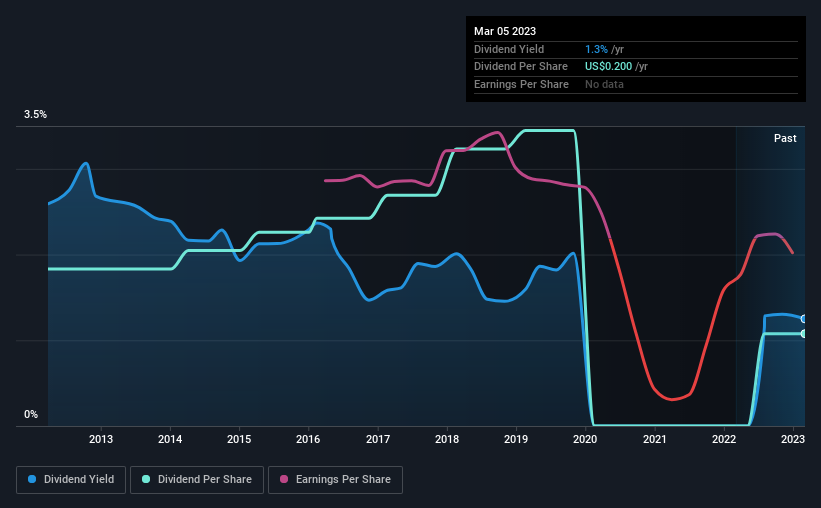We Wouldn't Be Too Quick To Buy The Marcus Corporation (NYSE:MCS) Before It Goes Ex-Dividend
Regular readers will know that we love our dividends at Simply Wall St, which is why it's exciting to see The Marcus Corporation (NYSE:MCS) is about to trade ex-dividend in the next 4 days. The ex-dividend date is usually set to be one business day before the record date which is the cut-off date on which you must be present on the company's books as a shareholder in order to receive the dividend. The ex-dividend date is an important date to be aware of as any purchase of the stock made on or after this date might mean a late settlement that doesn't show on the record date. Therefore, if you purchase Marcus' shares on or after the 10th of March, you won't be eligible to receive the dividend, when it is paid on the 20th of March.
The company's next dividend payment will be US$0.05 per share. Last year, in total, the company distributed US$0.20 to shareholders. Last year's total dividend payments show that Marcus has a trailing yield of 1.3% on the current share price of $16. Dividends are a major contributor to investment returns for long term holders, but only if the dividend continues to be paid. As a result, readers should always check whether Marcus has been able to grow its dividends, or if the dividend might be cut.
See our latest analysis for Marcus
Dividends are typically paid from company earnings. If a company pays more in dividends than it earned in profit, then the dividend could be unsustainable. Marcus reported a loss after tax last year, which means it's paying a dividend despite being unprofitable. While this might be a one-off event, this is unlikely to be sustainable in the long term. Given that the company reported a loss last year, we now need to see if it generated enough free cash flow to fund the dividend. If Marcus didn't generate enough cash to pay the dividend, then it must have either paid from cash in the bank or by borrowing money, neither of which is sustainable in the long term. It paid out 5.5% of its free cash flow as dividends last year, which is conservatively low.
Click here to see the company's payout ratio, plus analyst estimates of its future dividends.
Have Earnings And Dividends Been Growing?
Companies with falling earnings are riskier for dividend shareholders. If earnings decline and the company is forced to cut its dividend, investors could watch the value of their investment go up in smoke. Marcus was unprofitable last year and, unfortunately, the general trend suggests its earnings have been in decline over the last five years, making us wonder if the dividend is sustainable at all.
Another key way to measure a company's dividend prospects is by measuring its historical rate of dividend growth. Marcus's dividend payments per share have declined at 5.2% per year on average over the past 10 years, which is uninspiring. It's never nice to see earnings and dividends falling, but at least management has cut the dividend rather than potentially risk the company's health in an attempt to maintain it.
We update our analysis on Marcus every 24 hours, so you can always get the latest insights on its financial health, here.
To Sum It Up
Is Marcus worth buying for its dividend? It's hard to get used to Marcus paying a dividend despite reporting a loss over the past year. At least the dividend was covered by free cash flow, however. It's not an attractive combination from a dividend perspective, and we're inclined to pass on this one for the time being.
Wondering what the future holds for Marcus? See what the three analysts we track are forecasting, with this visualisation of its historical and future estimated earnings and cash flow
If you're in the market for strong dividend payers, we recommend checking our selection of top dividend stocks.
Have feedback on this article? Concerned about the content? Get in touch with us directly. Alternatively, email editorial-team (at) simplywallst.com.
This article by Simply Wall St is general in nature. We provide commentary based on historical data and analyst forecasts only using an unbiased methodology and our articles are not intended to be financial advice. It does not constitute a recommendation to buy or sell any stock, and does not take account of your objectives, or your financial situation. We aim to bring you long-term focused analysis driven by fundamental data. Note that our analysis may not factor in the latest price-sensitive company announcements or qualitative material. Simply Wall St has no position in any stocks mentioned.
Join A Paid User Research Session
You’ll receive a US$30 Amazon Gift card for 1 hour of your time while helping us build better investing tools for the individual investors like yourself. Sign up here

